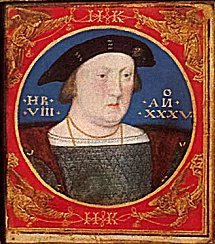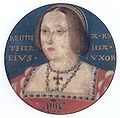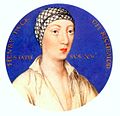Lucas Horenbout

Lucas Horenbout, often called Hornebolte in England (c. 1490/1495–1544), was a Flemish artist who moved to England in the mid-1520s and worked there as "King's Painter" and court miniaturist to King Henry VIII from 1525 until his death. He was trained in the final phase of Netherlandish illuminated manuscript painting, in which his father Gerard was an important figure, and was the founding painter of the long and distinct English tradition of portrait miniature painting. He has been suggested as the Master of the Cast Shadow Workshop, who produced royal portraits on panel in the 1520s or 1530s.
Life and family
Horenbout was born in
Horenbout came over to England at an unknown date with, or perhaps before, his sister
His father Gerard is first recorded in England in 1528, and later returned to the Continent, probably after 1531; he had died in Ghent by 1540. Susanna, who was also an illuminator, is recorded in 1529 as married to a John Palmer and in England.[7] Lucas is documented in England from September 1525, when he was first paid by the King as "pictor maker". By 1531 he was described as the "King's Painter", and this appointment was confirmed for life in June 1534, when he became a "denizen" - effectively a naturalised citizen. Horenbout was very well paid, at sixty-two pounds and ten shillings (but only thirty-three pounds and six
Margaret is credited with a number of paintings during his lifetime and one of Catherine Parr was attributed to him but it was painted after his death. He had left his studio to be unequally divided between his wife and his daughter. For many years his studio was paid by Catherine Parr for miniatures that his wife presumably created.[6]
Work

He can be said to be the founder of the English school of portrait miniature painting, which begins suddenly at the time of his arrival in England, and had very few continental precedents, although three lost miniatures, possibly by Jean Clouet, sent from the French to the English court, may have inspired the new form.[10] Horenbout later taught the art of illumination to Hans Holbein the Younger, also a court artist of Henry, at least according to Karel van Mander who refers to a "Lucas", assumed to be Horenbout. However, this has been doubted.[11]
Twenty-three surviving portrait miniatures have usually been attributed to Horenbout in recent decades; all but one, a portrait of Holbein, are of members of the English or other royal families. Paintings of at least four of Henry's Queens are attributed to him. A high proportion of those capable of being dated come from the 1520s.[9]
Horenbout's miniature of Holbein (1543) is among his most accomplished works, not least because he copies the face from a self-portrait drawing by Holbein; his own drawing skills are not the strongest.[12] This miniature was also nearly always regarded as a self-portrait, until recent technical examination made clear that the style of painting is actually very different from that of undoubted Holbein miniatures: there is "an absence of his subtle gradations of flesh tone and colour" and "no sign of the extremely thin pen-like lines which are so notable a feature in Holbein's drawing of such details as the embroidered edges of costume".[13] There are two versions attributed to Horenbout, of which the better is in the Wallace Collection[14] It may be a memorial portrait, painted in the six months interval between the death of Holbein and that of Horenbout.[15]
He is recorded as working in other forms, probably including panel paintings, woodcuts and decorations for festivities, but there are no certain survivals from these, except for illuminations on documents.[9] Roy Strong linked Horenbout with an artist known only as the Master of the "Cast Shadow Workshop", who produced a series of rather undistinguished portraits mostly of English monarchs past and present, presumably working for the King.[16]
Illuminated decorations on some charters, Acts and similar royal documents are also attributed to him,
Gallery
-
Catherine of Aragon with a monkey, 1525–26
-
Catherine of Aragon, 1525–26
-
Henry FitzRoy, 1st Duke of Richmond and Somerset, Henry VIII's illegitimate son, 1534-5
-
Jane Seymour, 1536–37
See also
Notes
- ^ Strong, 1983a, p.36
- Emperor Charles V
- ISBN 1-903973-28-7
- ^ possibly as early as 1522, says Reynolds, op cit
- ^ T Kren & S McKendrick, op cit, pp. 427-8
- ^ . Retrieved 27 March 2021.
- ^ Reynolds (2006):45
- ^ Strong 1983a, p. 34; although Gay in Kren:434 says only £33 6s
- ^ a b c d Gay op cit, p.434
- ^ Strong, 1983a, p.34
- ^ Rowlands, 88–90. Karel van Mander wrote in the early 17th century that "Lucas" taught Holbein illumination, but art historian John Rowlands downplays Horenbout's influence on Holbein's miniatures, which he believes follow the techniques of Jean Clouet and the French school.
- ^ Reynolds (1980) pp.33-39. The drawing is in the Uffizi image - "much retouched" and not universally accepted as an original Holbein (Reynolds (1980):38 & passim)
- ^ Reynolds,1980:38
- ^ The other is owned by the Duke of Buccleuch
- ^ Reynolds (1980):38
- ^ Strong 1983b:42–44
- ^ Strong 1983a:34
- ^ Gay op cit, No. 132, p.434-5
- ^ T Kren & S McKendrick op cit, Nos. 130 & 131, p.431-3
References
- T Kren & S McKendrick (eds),Illuminating the Renaissance: The Triumph of Flemish Manuscript Painting in Europe, Getty Museum/Royal Academy of Arts, 2003, ISBN 1-903973-28-7
- ISBN 0-905209-34-6(1983a) (includes twenty works attributed to Horenbout or the Cast Shadow Workshop).
- Strong, Roy: The English Renaissance Miniature, Thames and Hudson, 1983, ISBN 0-500-23370-5(1983b)
- Reynolds, Graham, Wallace Collection, Catalogue of Miniatures, 1980, Wallace Collection, London (1980)
- Reynolds, Graham; The Sixteenth and Seventeenth-Century Miniatures in the Collection of Her Majesty The Queen, Royal Collection Publications Ltd; 2006;ISBN 1-902163-45-1(2006)
- Rowlands, John. Holbein: The Paintings of Hans Holbein the Younger. Boston: David R. Godine, 1985. ISBN 0-87923-578-0
- van Elslande R.D.A. & A.H.J. de Kraker, De familie Horenbault: renaissancekunstenaars en cartografen te Gent en daarbuiten (ca. 1460 tot ca. 1630), in: Jaarboek 2004-2006 Oudheidkundige Kring "De Vier Ambachten", Hulst 2007, blz. 7–172.




